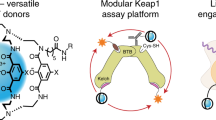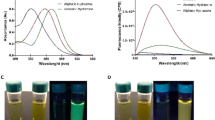Abstract
A low-molecular-weight molecule (4-(2-(3-(dicyanomethyl)-5,5-dimethylcyclohex-1-en-1-yl)vinyl)phenyl-benzoate, DDPB) has been developed. The organic framework possesses very weak fluorescence . The feasibility of the signal transduction has been performed via fluorometric titrations in solution. DDPB gives rise to responses to carboxylesterase 2 (CES2) based on “off-on” responses. The red emission at 670 nm has been derived from the enzyme-induced hydrolysis of ester linkages, thus suppressing the intramolecular charge transfer (ICT) effect and thereby generating the fluorescent segment. The optical excitation window for this probe is extended to the visible light range (λex = 516 nm), and it will induce less harmful influence on biological substances. The detection limit for the measurement of CES2 concentration is as low as 2.33 mU/mL. The conventional studies concerning the activation process are generally performed within only a single liveing cell system. In this study, it is the first time that expression of carboxylesterase 2 in five kinds of cell lines (HeLa > C1498 > active T cell > Jurkat > unactive T cell) has been clarified by flow cytometry, Western blotting, and confocal microscopy analysis. The elucidation of CES2 and its variability in a variety of cells will open new ways for drug metabolism and disease prevention.

We reported a new “substrate-mediated light-on” strategy based on an ester bond cleavage reaction. Most of prepared nanomaterials and organic fluorophores possessed short wavelength emissions in the blue or green region which will not be difficult for cellular imaging. In this study, a novel functional molecule (DDPB) was considered as the substrate for CES2 and the optical “off-on” response was realized. DDPB was cell permeable and possessed very low cytotoxicity. Moreover, the identification of CES2 and their subtle changes in five different cells afforded the sequence for carboxylesterase-2 as Hela > C1498 > Active T cell > Jurkat > Unactive T cell. Inhibition studies showed that the hydrolysis of DDPB was effectively suppressed by bis-p-nitrophenyl phosphate and the cellular tracking results firmly supported this point. To our knowledge, the inter-individual variability for the CES2 expressions in five different cell lines has never been reported via the substrate induced optical changes.









Similar content being viewed by others
References
Kawamata H, Kawai K, Kameyama S, Johnson MD, Stetler-Stevenson WG, Oyasu R (1995) Over-expression of tissue inhibitor of matrix metalloproteinases (TIMP1 and TIMP2) suppresses extravasation of pulmonary metastasis of a rat bladder carcinoma. Int J Cancer 63(5):680–687
Godin SJ, Crow JA, Scollon EJ, Hughes MF, DeVito MJ, Ross MK (2007) Identification of rat and human cytochrome p450 isoforms and a rat serum esterase that metabolize the pyrethroid insecticides deltamethrin and esfenvalerate. Drug Metab Dispos 35(9):1664–1671
Tang LJ, Li FF, Liu MH, Nandhakumar R (2011) Single sensor for two metal ions: colorimetric recognition of Cu2+ and fluorescent recognition of Hg2+. Spectrochim Acta A 78:1168–1172
Yang XL, Zhang YS, Liu WQ, Gao JW, Zheng YH (2019) Confined synthesis of phosphorus, nitrogen co-doped carbon dots with green luminescence and anion recognition performance. Polyhedron 171:389–395
Wu NT, Liu XY, Zeng M, Gao JW, Lu XB, Zeng Z, Zheng YH (2019) Controllable synthesis of novel luminescent CuFeS2 quantum dots with magnetic properties and cation sensing features. J Nanopart Res 21:268
Shi XB, Li MM, Zhao WF, Liang AY, Liu XJ, Gai HW (2015) Spectral imaging superlocalization microscopy for quantum dots. Sensor Actuat B-Chem 207:308–312
Liu XY, Gao JW, Zhou GF, Liu WQ, Wang QM, Zheng YH (2020) Low molecular weight molecule induces the effective stabilization of CsPbBr3 in water. J Mol Liq 299:112199
Jiang CX, Tang YP, Zeng Z, Gao JW, Li MS, Zheng YH (2019) Structural determination of europium incorporated Mo2C microrods and photoluminescence studies. Polyhedron 157:416–419
Zhou Z, Wang QM, Zhang CC, Gao JW (2016) Molecular imaging of biothiols and in vitro diagnostics based on an organic chromophore bearing a terbium hybrid probe. Dalton Trans 45:7435–7442
Chen MH, Wen Q, Gu F, Gao J, Zhang CC, Wang QM (2018) Mussel chemistry assembly of a novel biosensing nanoplatform based on polydopamine fluorescent dot and its photophysical features. Chem Eng J 342:331–338
Wu NT, Yu AW, Zhang LB, Liu WQ, Gao JW, Zhang CC, Zheng YH (2019) Biocompatible nanoplatform based on mussel adhesive chemistry: effective assembly, dual mode sensing and cellular imaging performance. Adv Mater Interfaces 6:1900732
Lin JT, Zheng YH, Wang QM, Zeng Z, Zhang CC (2014) Novel lanthanide pH fluorescent probes based on multiple emissions and its visible-light-sensitized feature. Anal Chim Acta 839:51–58
Gabriele M, Puccini P, Lucchi M, Vizziello A, Gervasi PG, Longo V (2018) Presence and inter-individual variability of carboxylesterases (CES1 and CES2) in human lung. Biochem Pharmacol 150:64–71
Yu AW, Tang YP, Li K, Gao JW, Zheng YH, Zeng Z (2019) Tunable photoluminescence studies based on blue-emissive carbon dots and sequential determination of Fe(III) and pyrophosphate ions. Spectrochim Acta A 222:117231
Zhou Z, Gu JP, Chen YZ, Zhang XX, Wu HX, Qiao XG (2019) Europium functionalized silicon quantum dots nanomaterials for ratiometric fluorescence detection of Bacillus anthrax biomarker. Spectrochim Acta A 212:88–93
Zhou Z, Han ML, Fu HR, Ma LF, Luo F, Li DS (2018) Engineering design toward exploring the functional group substitution in 1D channels of Zn-organic frameworks upon nitro explosives and antibiotics detection. Dalton Trans 47:5359–5365
Ahmad I, Zhou Z, Li HY, Zang SQ (2020) Crafting CeTe/CdS QDs surface for the selective recognition of formaldehyde gas via ratiometric contrivance. Sensor Actuat B-Chem 304:127379
Seo J, Kim S, Park SY (2004) Strong solvatochromic fluorescence from the intramolecular charge-transfer state created by excited-state intramolecular proton transfer. J Am Chem Soc 126(36):11154–11155
Jin Q, Feng L, Wang D-D, Dai Z-R, Wang P, Zou L-W, Liu Z-H, Wang J-Y, Yu Y, Ge G-B (2015) A two-photon ratiometric fluorescent probe for imaging carboxylesterase 2 in living cells and tissues. ACS Appl Mater Interfaces 7(51):28474–28481
Zhou Z, Li XQ, Tang YP, Zhang CC, Fu HR, Wu NT, Ma LF, Gao JW, Wang QM (2018) Oxidative deoximation reaction induced recognition of hypochlorite based on a new fluorescent lanthanide-organic framework. Chem Eng J 351:364–370
Zhou Z, Wu HX, Li FF, Ma LF, Qiao XG (2020) Hypochlorite responsive ratiometric fluorescent switch and logic gates based on lanthanide functionalized polymer nanosphere. Dyes Pigments 174:108033
Zhou Z, Gu JP, Qiao XG, Wu HX, Fu HR, Wang L, Li HY, Ma LF (2019) Double protected lanthanide fluorescence core@shell colloidal hybrid for the selective and sensitive detection of ClO−. Sensor Actuat B-Chem 282:437–442
Jin Q, Feng L, Wang D-D, Wu J-J, Hou J, Dai Z-R, Sun S-G, Wang J-Y, Ge G-B, Cui J-N (2016) A highly selective near-infrared fluorescent probe for carboxylesterase 2 and its bioimaging applications in living cells and animals. Biosens Bioelectron 83:193–199
Feng L, Liu Z-M, Hou J, Lv X, Ning J, Ge G-B, Cui J-N, Yang L (2015) A highly selective fluorescent ESIPT probe for the detection of human carboxylesterase 2 and its biological applications. Biosens Bioelectron 65:9–15
Liu Z-M, Feng L, Hou J, Lv X, Ning J, Ge G-B, Wang K-W, Cui J-N, Yang L (2014) A ratiometric fluorescent sensor for highly selective detection of human carboxylesterase 2 and its application in living cells. Sensor Actuat B-Chem 205:151–157
Lin JT, Wang QM (2014) Systematic studies for the novel synthesis of nano-structured lanthanide fluorides. Chem Eng J 250:190–197
Zhou Z, Zhang CC, Zheng Y, Wang QM (2018) Luminescence modulation of two individual fluorophores over a wide pH range and intracellular studies. Dyes Pigments 150:151–157
Imai T, Taketani M, Shii M, Hosokawa M, Chiba K (2006) Substrate specificity of carboxylesterase isozymes and their contribution to hydrolase activity in human liver and small intestine. Drug Metab Dispos 34:1734–1741
Zhou Z, Zhang CC, Zheng Y, Wang Q (2016) Aggregation induced emission mediated controlled release by using a built-in functionalized nanocluster with theranostic features. J Med Chem 59(1):410–418
Li X, Zhou Z, Tang Y, Zhang CC, Zheng Y, Gao J, Wang Q (2018) Modulation of assembly and disassembly of a new tetraphenylethene based nanosensor for highly selective detection of hyaluronidase. Sensor Actuat B-Chem 276:95–100
Halabi EA, Thiel Z, Trapp N, Pinotsi D, Rivera-Fuentes P (2017) A photoactivatable probe for super-resolution imaging of enzymatic activity in live cells. J Am Chem Soc 139(37):13200–13207
Zhao Q, Zhou X, Cao T, Zhang KY, Yang L, Liu S, Liang H, Yang H, Li F, Huang W (2015) Fluorescent/phosphorescent dual-emissive conjugated polymer dots for hypoxia bioimaging. Chem Sci 6(3):1825–1831
Xu G, Zhang W, Ma MK, McLeod HL (2002) Human carboxylesterase 2 is commonly expressed in tumor tissue and is correlated with activation of irinotecan. Clin Cancer Res 8(8):2605–2611
Tang X, Wu H, Wu Z, Wang G, Wang Z, Zhu D (2008) Carboxylesterase 2 is downregulated in colorectal cancer following progression of the disease. Cancer Investig 26(2):178–181
Muta K, Fukami T, Nakajima M (2015) A proposed mechanism for the adverse effects of acebutolol: CES2 and CYP2C19-mediated metabolism and antinuclear antibody production. Biochem Pharmacol 98(4):659–670
Zhou Z, Gu FL, Peng L, Hu Y, Wang QM (2015) Spectroscopic analysis and in vitro imaging applications of a pH responsive AIE sensor with a two-input inhibit function. Chem Commun 51:12060–12063
Wu NT, Yu AW, Gao JW, Liu WQ, Wang QM (2020) Sodium sulfite leads to the formation of fluorescent organic nanoparticles: regulation from aqueous solution, cellular pathway to security design patterns. Dyes Pigments 176:108252
Ciotta E, Prosposito P, Pizzoferrato R (2019) Positive curvature in Stern-Volmer plot described by a generalized model for static quenching. J Lumin 206:518–522
Acknowledgments
J. W. thanks grants from National Natural Science Foundation of China (NSFC)-Guangdong Joint funding support (No. U1801256) and Innovation team project by the Department of Education of Guangdong Province (2016KCXTD009). Q.M. thanks for the support from Basic Research Fund of Guangzhou city (20200401).
Author information
Authors and Affiliations
Corresponding author
Ethics declarations
Conflict of interest
The authors declare that they have no conflict of interest.
Additional information
Publisher’s note
Springer Nature remains neutral with regard to jurisdictional claims in published maps and institutional affiliations.
Electronic supplementary material
ESM 1
(DOCX 3053 kb)
Rights and permissions
About this article
Cite this article
Liu, X., Li, X., Dong, P. et al. Near-infrared emission tracks inter-individual variability of carboxylesterase-2 via a novel molecular substrate. Microchim Acta 187, 313 (2020). https://doi.org/10.1007/s00604-020-04296-6
Received:
Accepted:
Published:
DOI: https://doi.org/10.1007/s00604-020-04296-6




